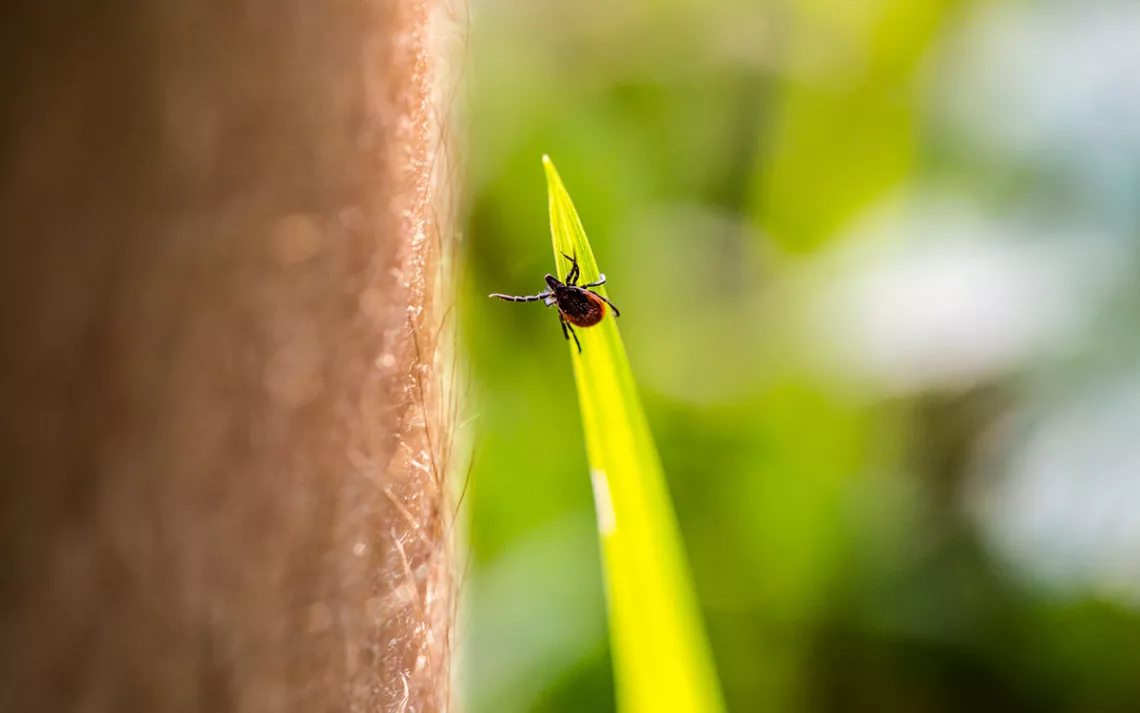What’s Behind the Rise of Ticks and Tick-Borne Illnesses?
It’s not just climate change. Land use change, forest fragmentation, and suburbanization are also driving this public health issue.

Photo by kmatija/iStock
When I was a kid, my family moved from a suburb in Massachusetts to rural Vermont. Moving to a new place can be tough, but one part of the change made me giddy with excitement: There were hardly any ticks in Vermont. In Massachusetts, I spent summer days playing outside and evenings being tweezed to death as my mom extracted deer ticks from my legs, belly, even my scalp. They were inescapable. The thought of moving to a place where I wouldn’t have to fear these pesky arachnids was like a dream come true.
For the first few years in Vermont, I never came home with a tick. But that was over a decade ago. As time passed, things started to change. My mom pulled ticks off herself after working in the garden. The dog had them crawling in her fur. Neighbors came down with Lyme disease or anaplasmosis. Now, it seems like the pests have gained the upper hand in our once-tick-free state.
This situation isn’t unique to Vermont. Throughout the country, public health experts are ringing alarm bells about rising cases of tick-borne illnesses. Experts point to climate change as a key factor driving range expansion, increasing abundance, and lengthening periods of activity for ticks. In fact, ticks now remain active year-round, even during the coldest winter months, says Patti Casey, director of tick surveillance programs for Vermont’s Agency of Agriculture. Last year, she found three active ticks in February.
But climate change isn’t the only factor influencing tick season. The way we use and develop land has a big impact on ticks too, according to Dr. Rick Ostfeld, a distinguished senior scientist at the Cary Institute of Ecosystem Studies. He studies how environmental variables affect ticks and tick-borne illnesses. After years of observing how Lyme disease responded to warming temperatures, he felt like there was more to the story. “There are parts of the US where Lyme disease is getting worse that are already warm,” says Ostfeld, citing the Carolinas and Virginia as two examples. Climate change “clearly doesn’t explain it all,” he says.
That observation motivated Ostfeld and his colleagues to look at another potential driver: land use change. Their research shows that species diversity within forests plays an important role in protecting human communities from these diseases.
To understand how this works, one needs to know how ticks become infected. Let’s use deer ticks as an example—they’re the biggest spreaders of tick-borne disease in the country. Ticks have three active life stages: larva, nymph, and adult. They need one blood meal at each stage to survive. In the spring, larval deer ticks wait patiently on the forest floor for a small vertebrate—like a rodent—to become their first victim. In eastern and central US forests, a common host for tick larvae is the white-footed mouse—a carrier of Lyme disease, anaplasmosis, babesiosis, and other diseases that ticks can spread to humans.
When ticks hatch in an environment where disease-carrying rodents are highly concentrated, they’re more likely to take their first blood meal from an infected host, explains Ostfeld. Once an infected tick molts into a nymph in the spring or summer, it can attach to humans and make them sick.
So, fewer disease-carrying rodents should generate fewer infected ticks. Two situations can reduce the odds of a larval tick feeding on a rodent. The first is a direct reduction in the population density of rodents, and the second is a greater diversity of other types of hosts in the forest. For example, lizards and ground-dwelling birds are favorable hosts for a recently hatched tick, but they’re far less likely to infect the tick with disease.
This is the dilution effect. A diverse array of forest-dwelling species dilutes disease transfer from hosts to ticks, adding a layer of protection between humans and tick-borne disease. But when humans clear and develop forests, this dynamic changes.
Picture your average suburb. When people clear land for development, they break up forests into smaller patches of trees surrounded by human communities. Research shows that forest biodiversity decreases as patch size decreases, but rodent density goes up. One explanation for this is that rodent predators are some of the first species to flee when their habitat becomes fragmented. Raptors, for instance, need lots of space to hunt for their prey. When their habitat shrinks, they go looking for intact forests that will serve their needs. This throws a tick’s blood meal menu out of balance: When predators leave, rodent populations boom.
These patches are teeming with disease-infected ticks. But it’s their proximity to human communities that makes them dangerous. “Not only are we making risk go up by fragmenting the landscape, but we’re also plunking communities right down in those risky environments,” says Ostfeld.
The spaces we love can be the most dangerous. Ticks thrive at the forest edge, explains Casey of Vermont’s Agency of Agriculture. “Yards, garden edges—they love ecotones where the field and the trees come together,” she says. In her fieldwork, she often finds ticks clustered at trailheads, waiting for unwitting hikers to sink their mouth-parts into.
The dilution effect adds another layer of complexity to how humans influence tick-borne disease. When factoring in climate change, disease trends become even more complicated. But one thing is clear: As we continuously fragment forests and build around them, tick-borne illnesses will increasingly infiltrate our communities.
 The Magazine of The Sierra Club
The Magazine of The Sierra Club



